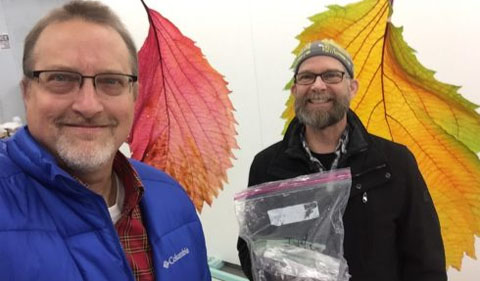
John Sabraw, right, is holding plastic bags containing dirt from Iwate and Aichi brought back by Chris Thompson to make into paint for the mural project. This photo was taken in December 2019.
From Ohio University News
Ohio University professors John Sabraw and Chris Thompson recently teamed up for a “global engagement” opportunity through art, uniting students and faculty from OHIO and two partner institutions in Japan.
Thompson, Associate Professor of Linguistics, is a veteran Japan specialist. Sabraw, Professor and Chair of Painting + Drawing, is an internationally exhibiting artist.
Their latest project is an inspirational mural on a 48-foot seawall protecting Tarō, Japan, a city in Iwate Prefecture devastated by a 2011 tsunami that claimed more than 15,000 lives.
The mural project was conceived in September 2019, when Shūichi Daibō, chairman of the relief organization NPO Tsunami Tarō, requested the collaborative help of Thompson and OHIO on a long-term project to paint an inspirational mural on one of their newest and tallest seawalls. The mural project is dubbed the U.S.-Japan Global Engagement Project.
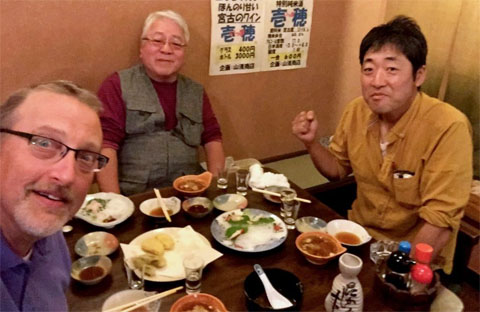
Chris Thompson with NGO Tsunami Tarō Chairman Daibō and Vice Chairman Tamazawa at the meeting where collaborative help from OHIO was requested on their seawall mural in September 2019.
“I immediately thought of John Sabraw,” Thompson explains as he considered potential OHIO faculty who could work with him on this project. “The only OHIO artist with experience in Asia, a serious and longstanding interest in Japan, and proven knowledge, expertise and skill to help us pull something like this off would be John!”
“When Chris approached me about this project in January, and I learned that Iwate Prefectural University and Chubu University students would be on campus in early spring, there was only one thought in my mind,” Sabraw says. “We need to take advantage of their presence and bring them together with our students to begin planning!”
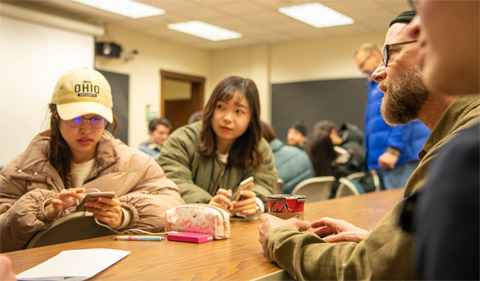
OHIO professors John Sabraw (right) and Chris Thompson (background) meet with Chubu University students during their visit to Athens in early 2020. Photo by Ben Siegel/Ohio University
Envisioning a ‘Warm-Up’ Sibling Mural
After thoughtful consideration, Sabraw proposed a “sibling mural” to be painted here in Athens, designed and crafted by students, that incorporates key signs, symbols and scenery from the three universities as a “warm-up” to the Tarō mural.
The first meeting took place in February. Sabraw and his students invited Dr. Kensuke Emura of Iwate Prefectural University—already in Athens with 10 of his students—to his studio, along with a handful of Thompson’s prospective fall 2020 Japan study away students who are planning to study at Chubu University and travel to Iwate for the U. S. – Japan Global Engagement Project at Iwate. During the meetings, students brainstormed ideas for the mural.
One week later, Sabraw and Thompson repeated the meeting with 13 Chubu University students, right before they were called back to Japan by their university due to COVID-19.
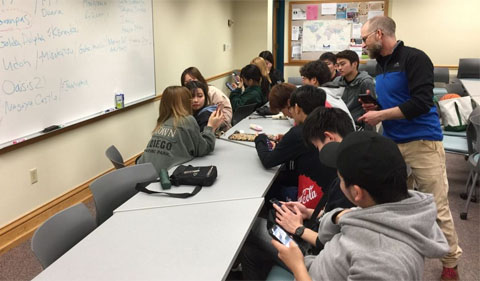
Sabraw with Chubu students, brainstorming ideas and looking up Aichi symbols on their phones for the “sibling mural” in February.
Based on those meetings, Sabraw’s art students are now developing a design draft that Thompson will share electronically with Iwate Prefectural and Chubu students, now back in their home cities. After incorporating this feedback, the design will be then be further refined into the planned sibling mural here in Athens.
Utilizing the process Sabraw developed with Russ College of Engineering and Technology Professor Guy Riefler to create paint pigment out of toxic sludge from abandoned local coal mines, he has generated paint for the Japan mural project using dirt from Iwate (Tarō) and Aichi (Chubu campus) to be used in the 2020 mural project. This adds a very unique ecological sustainability component to the mural project.
The sibling mural, initially conceived as something that would go on a stationary wall somewhere in Athens, is now being re-imagined. Sabraw and Thompson are considering possibilities for getting the mural to Iwate and Aichi for public display.
This will enable them to more effectively convey the environmental responsibility elements of the project and to celebrate the three-way institutional relationship of OHIO, Chubu and Iwate Prefectural in the U.S.-Japan Global Engagement Project.
“Due to COVID-19, it is most likely that the ‘sibling’ mural will be digitally created so that each university can then print it out at a size that will fit an appropriate location chosen locally. With this digital mural as a jumping off point, ideally, our team would then work with IPU faculty and students, Tarō officials and citizens, as well as local artists to come up with a new full design for the seawall and how to best execute it,” Sabraw says. “We are so excited about this!”
Preparing for the Seawall Mural
The mural on the 48-foot seawall is requested to be a scene depicting hamamukae, literally meaning “a welcome back to shore.”
“In Tarō fishing culture, hamamukae evokes an image of families and members of the local community thankful for the safe return of the fishermen and fisherwomen, welcoming them back to port. But without John actually visiting Tarō, I knew it would be almost impossible for him to imagine and depict what this might look like,” Thompson says. “So he will begin drafts of this image with whoever the mural participants end up being when he actually gets to spend some time there. Daibō and (NPO Tsunami Tarō Vice President Kunihiko) Tamazawa have some examples to inspire John to work from that were depicted on the seawalls destroyed in the 2011 tsunami.
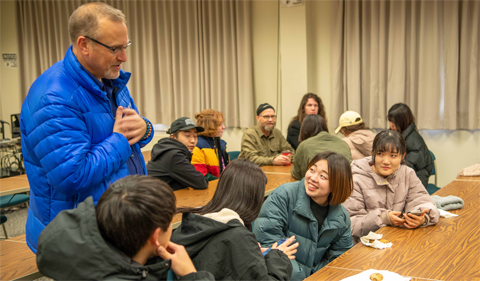
One week later, Sabraw and Thompson repeated the meeting with 13 Chubu University(opens in a new window) students, right before they were called back to Japan by their university due to COVID-19. Photo by Ben Siegel/Ohio University
“As far as the Athens ‘sibling mural’ goes, I think we were after a combination of visual images from Iwate including Tarō, Nagoya, and Athens. Students from each of these places were contributing ideas that would be compiled by John’s art students,” Thompson added.
International and Alumni Involvement
Iwate Prefectural professors Emura, Tomomasa Sasa, and OHIO alum Pat Maher (M.A., Linguistics ’07) are already fully on board with the project.
At Chubu, Drs. Kae Takarabe (College of International Studies), Tadashi Shiozawa, and Tomo Miyagi, as well as OHIO alumni Greg King (M.A., Linguistics ’99) and David Laurence (M.A., Linguistics ’07) from the English and American Studies Department in the College of Humanities) are among the faculty who will host the mural project there.
Maher, King and Laurence all earned a master’s in Linguistics from the College of Arts at OHIO.
The COVID-19 pandemic will undoubtedly affect the timing and the logistics of the project, but Sabraw and Thompson, with the help of their student and faculty partners in Japan, are poised with their collaborators in Tarō to see the project to fruition in the next couple of years.
A Relationship Dating to the 2011 Tsunami
This global engagement idea piggybacks on a project Thompson has been spearheading since September of 2011, when he began taking OHIO students, faculty and alumni to Iwate Prefecture in Japan following the most devastating tsunami ever to occur there. In partnership with Iwate Prefectural University, the clean-up project has become an annual service learning event. Thompson’s extensive fieldwork connections as a cultural anthropologist in the region allowed him to put the program together.
In 2014, with Iwate Prefectural University’s blessing, Thompson expanded the program by inviting Chubu University students and faculty to join the effort. One of the many positive results of the project has been a new friendship between the two Japan universities and Ohio University, resulting in Iwate Prefectural students traveling to OHIO each spring (like Chubu students) to study English in the Ohio Program of Intensive English (OPIE).
Nine-years-on, Thompson was looking to expand the success of this annual service learning initiative (funded by both Ohio University and the U.S. Embassy in Tokyo over the years) to include community support activities in Aichi Prefecture (home of Chubu) and Athens, Ohio, to provide more opportunities for students from the three universities to interact more closely under a new name, the U.S.-Japan Global Engagement Project.


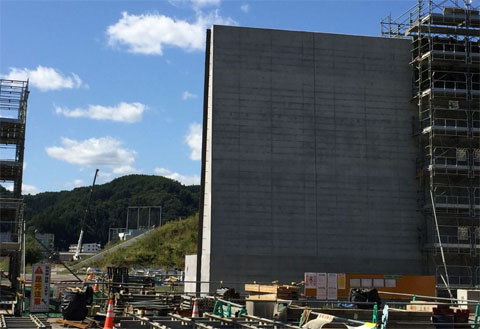
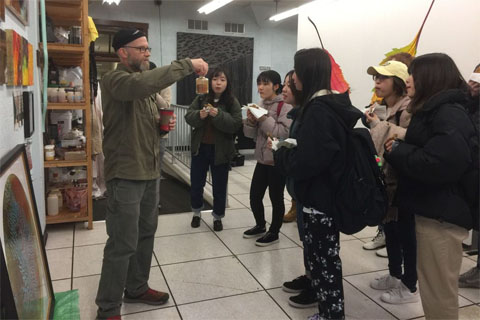

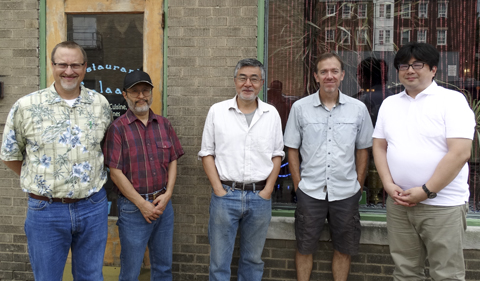















Comments